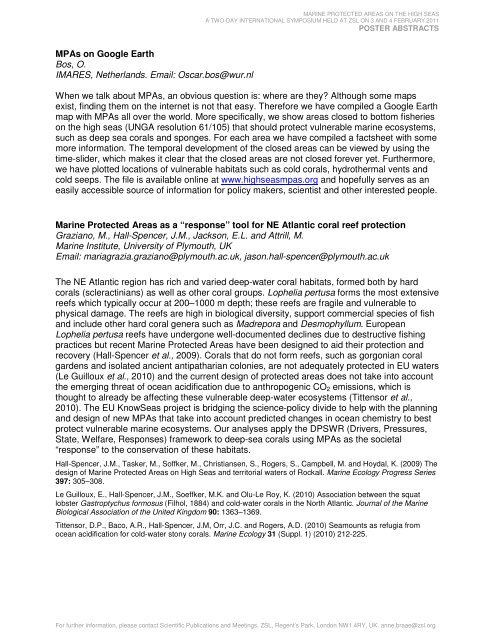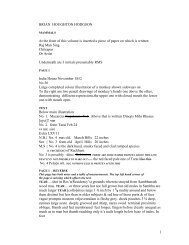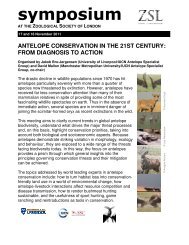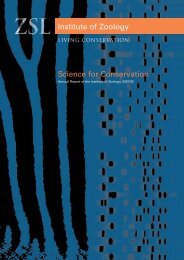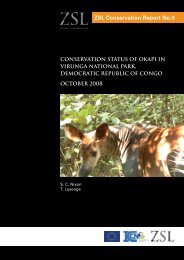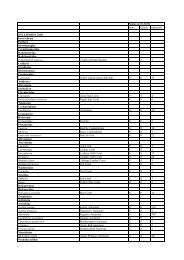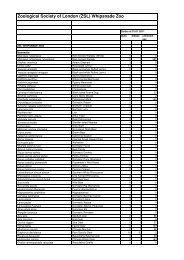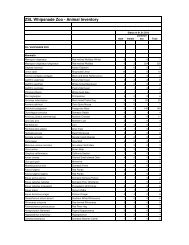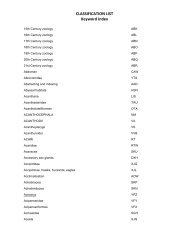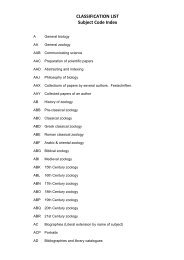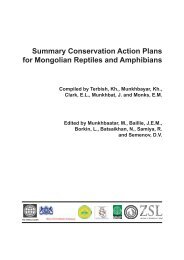MPA Symposium - Zoological Society of London
MPA Symposium - Zoological Society of London
MPA Symposium - Zoological Society of London
You also want an ePaper? Increase the reach of your titles
YUMPU automatically turns print PDFs into web optimized ePapers that Google loves.
<strong>MPA</strong>s on Google Earth<br />
Bos, O.<br />
IMARES, Netherlands. Email: Oscar.bos@wur.nl<br />
MARINE PROTECTED AREAS ON THE HIGH SEAS<br />
A TWO-DAY INTERNATIONAL SYMPOSIUM HELD AT ZSL ON 3 AND 4 FEBRUARY 2011<br />
POSTER ABSTRACTS<br />
When we talk about <strong>MPA</strong>s, an obvious question is: where are they? Although some maps<br />
exist, finding them on the internet is not that easy. Therefore we have compiled a Google Earth<br />
map with <strong>MPA</strong>s all over the world. More specifically, we show areas closed to bottom fisheries<br />
on the high seas (UNGA resolution 61/105) that should protect vulnerable marine ecosystems,<br />
such as deep sea corals and sponges. For each area we have compiled a factsheet with some<br />
more information. The temporal development <strong>of</strong> the closed areas can be viewed by using the<br />
time-slider, which makes it clear that the closed areas are not closed forever yet. Furthermore,<br />
we have plotted locations <strong>of</strong> vulnerable habitats such as cold corals, hydrothermal vents and<br />
cold seeps. The file is available online at www.highseasmpas.org and hopefully serves as an<br />
easily accessible source <strong>of</strong> information for policy makers, scientist and other interested people.<br />
Marine Protected Areas as a “response” tool for NE Atlantic coral reef protection<br />
Graziano, M., Hall-Spencer, J.M., Jackson, E.L. and Attrill, M.<br />
Marine Institute, University <strong>of</strong> Plymouth, UK<br />
Email: mariagrazia.graziano@plymouth.ac.uk, jason.hall-spencer@plymouth.ac.uk<br />
The NE Atlantic region has rich and varied deep-water coral habitats, formed both by hard<br />
corals (scleractinians) as well as other coral groups. Lophelia pertusa forms the most extensive<br />
reefs which typically occur at 200–1000 m depth; these reefs are fragile and vulnerable to<br />
physical damage. The reefs are high in biological diversity, support commercial species <strong>of</strong> fish<br />
and include other hard coral genera such as Madrepora and Desmophyllum. European<br />
Lophelia pertusa reefs have undergone well-documented declines due to destructive fishing<br />
practices but recent Marine Protected Areas have been designed to aid their protection and<br />
recovery (Hall-Spencer et al., 2009). Corals that do not form reefs, such as gorgonian coral<br />
gardens and isolated ancient antipatharian colonies, are not adequately protected in EU waters<br />
(Le Guilloux et al., 2010) and the current design <strong>of</strong> protected areas does not take into account<br />
the emerging threat <strong>of</strong> ocean acidification due to anthropogenic CO2 emissions, which is<br />
thought to already be affecting these vulnerable deep-water ecosystems (Tittensor et al.,<br />
2010). The EU KnowSeas project is bridging the science-policy divide to help with the planning<br />
and design <strong>of</strong> new <strong>MPA</strong>s that take into account predicted changes in ocean chemistry to best<br />
protect vulnerable marine ecosystems. Our analyses apply the DPSWR (Drivers, Pressures,<br />
State, Welfare, Responses) framework to deep-sea corals using <strong>MPA</strong>s as the societal<br />
“response” to the conservation <strong>of</strong> these habitats.<br />
Hall-Spencer, J.M., Tasker, M., S<strong>of</strong>fker, M., Christiansen, S., Rogers, S., Campbell, M. and Hoydal, K. (2009) The<br />
design <strong>of</strong> Marine Protected Areas on High Seas and territorial waters <strong>of</strong> Rockall. Marine Ecology Progress Series<br />
397: 305–308.<br />
Le Guilloux, E., Hall-Spencer, J.M., Soeffker, M.K. and Olu-Le Roy, K. (2010) Association between the squat<br />
lobster Gastroptychus formosus (Filhol, 1884) and cold-water corals in the North Atlantic. Journal <strong>of</strong> the Marine<br />
Biological Association <strong>of</strong> the United Kingdom 90: 1363–1369.<br />
Tittensor, D.P., Baco, A.R., Hall-Spencer, J.M, Orr, J.C. and Rogers, A.D. (2010) Seamounts as refugia from<br />
ocean acidification for cold-water stony corals. Marine Ecology 31 (Suppl. 1) (2010) 212-225.<br />
For further information, please contact Scientific Publications and Meetings, ZSL, Regent’s Park, <strong>London</strong> NW1 4RY, UK. anne.braae@zsl.org


